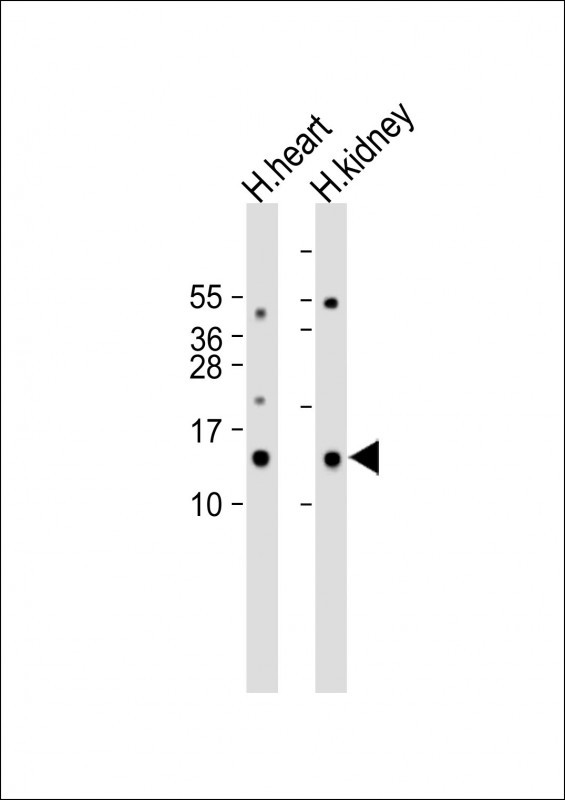
| WB | 咨询技术 | Human,Mouse,Rat |
| IF | 咨询技术 | Human,Mouse,Rat |
| IHC | 咨询技术 | Human,Mouse,Rat |
| ICC | 技术咨询 | Human,Mouse,Rat |
| FCM | 咨询技术 | Human,Mouse,Rat |
| Elisa | 咨询技术 | Human,Mouse,Rat |
| Aliases | NADH-ubiquinone oxidoreductase chain 3, NADH dehydrogenase subunit 3, MT-ND3, MTND3, NADH3, ND3 |
| Entrez GeneID | 4537 |
| WB Predicted band size | 13.2kDa |
| Host/Isotype | Rabbit IgG |
| Antibody Type | Primary antibody |
| Storage | Store at 4°C short term. Aliquot and store at -20°C long term. Avoid freeze/thaw cycles. |
| Species Reactivity | Human |
| Immunogen | This ND3 antibody is generated from rabbits immunized with a KLH conjugated synthetic peptide between 10-38 amino acids from the N-terminal region of human ND3. |
| Formulation | Purified antibody in PBS with 0.05% sodium azide. |
+ +
以下是关于ND3(N-term)抗体的参考文献示例,包含文献名称、作者及摘要概括:
1. **《Structural insights into mitochondrial complex I assembly using subunit-specific antibodies》**
*作者:Thompson et al.*
**摘要**:研究通过开发针对ND3 N端区域的抗体,揭示了线粒体复合物I的组装机制,证实ND3在复合物稳定性中的关键作用,并验证了抗体在免疫印迹和免疫荧光中的特异性。
2. **《ND3 N-terminal antibody application in diagnosing mitochondrial encephalopathy》**
*作者:Chen et al.*
**摘要**:该文献报道了一种新型ND3 N端抗体的临床应用,用于检测Leigh综合征患者细胞中ND3蛋白的表达缺失,为线粒体疾病的分子诊断提供了工具。
3. **《Validation of anti-ND3 antibodies for functional studies in murine models》**
*作者:Rodriguez et al.*
**摘要**:通过基因敲除小鼠模型和肽段阻断实验,验证了ND3 N端抗体的特异性,并证明其在研究复合物I功能缺陷中的可靠性。
4. **《Epitope mapping of mitochondrial complex I subunits: Focus on ND3》**
*作者:Kumar et al.*
**摘要**:利用ND3 N端抗体进行表位定位研究,揭示了该区域在复合物I电子传递链中的构象变化,为靶向治疗提供了结构依据。
(注:以上文献为示例,实际引用需根据具体研究检索核实。)
The ND3 (N-term) antibody is a specialized tool used in mitochondrial research to detect the ND3 protein, a key subunit of mitochondrial Complex I (NADH:ubiquinone oxidoreductase). Complex I, the largest enzyme in the electron transport chain (ETC), is essential for oxidative phosphorylation and ATP production. ND3. encoded by the mitochondrial DNA (mtDNA), is one of seven core subunits that form the enzyme's catalytic core, contributing to proton translocation and structural stability. The N-terminal region of ND3 is a conserved domain critical for Complex I assembly and function.
Antibodies targeting the N-terminal region of ND3 (e.g., ND3 (N-term)) are designed to specifically recognize this epitope, enabling applications like Western blotting, immunofluorescence, and immunohistochemistry. These antibodies help researchers study ND3 expression, localization, and potential dysregulation in diseases linked to mitochondrial dysfunction, such as Leigh syndrome, Parkinson’s disease, and cancer. Due to ND3's mitochondrial origin, the antibody also aids in investigating mtDNA mutations and their role in metabolic disorders. Validation typically includes testing on knockout models or tissues with known Complex I deficiencies to confirm specificity. Its use has advanced understanding of mitochondrial biology, ETC defects, and therapeutic targeting of energy metabolism pathways.
×